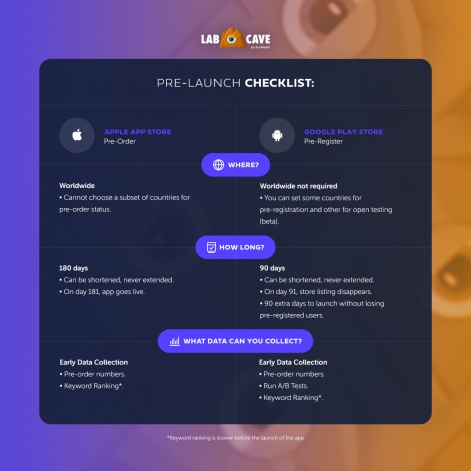You’ve developed your app, tested its functions thoroughly and got to the point where it’s just about ready for the world to enjoy. Launching an app is a huge moment - congratulations. But you only get one shot to get it right.
In this article, you will find practical steps from Lab Cave’s mobile marketing experts that you can do prior to - and in the soft launch phase - that should give your app the best possible chance of a successful launch.
Scheduling
Firstly, set a schedule. Even when soft-launching your app, having a schedule to work towards will keep you focused on the next milestone and ensure you don’t miss something in all the craziness of launch.
There are many moving parts and a good schedule will factor in the development, user acquisition (UA), app store optimisation (ASO), public relations (PR) etcetera, so that there is clarity among teams.
Tools like Trello, Jira, Mantis, Tom’s Planner etcetera. are great for quickly building out a schedule that can link to a shared calendar, so everyone on your team has visibility, understands how milestones affect their work and are moving in the same direction.
Coordinating your teams effectively can remove many headachesLab Cave
Delays can and will happen. Adjusting your schedule can have an impact on many different parts of your launch, so having clear communication across your team (and understanding who will be affected before you enact a change) is crucial. Coordinating your teams effectively can remove many headaches and mean that the benefits to any adjustments made are felt as quickly as possible.
App store optimisation
With a structure and calendar in place, let's talk about three of the most important letters in the soft launch process, ASO. ASO need not be scary. You can make a bunch of ASO decisions ahead of time that will help in being more proactive than reactive.
For example, what is the purpose of your soft launch? Do you want to test retention and user flow, make sure your monetisation loops are solid or are you still deciding on some items like the title?
Perhaps it is discovered that the title is not resonating with users and you decide to change it. Suddenly all of your ASO will need to change along with it. You may need to adjust your descriptions to reflect a new word you want to rank for. Things can quickly get complicated
Clearly, these decisions can have a huge impact on the structure of your ASO campaign. While answers may not come straight away, having a plan in place for potential eventualities means it can be factored into your overall strategy before you’re forced into a decision.
User acquisition
UA is another area where planning ahead can make all the difference. Before you even launch your store page it should be UA-optimised so that your UA campaign is aligned with what you have on your store page.
Users want ad click-through to take them directly to the store page. When the ad creative looks nothing like the store page, users can feel like they went to the wrong app. Anything which gets in the way of the click-through rate should be identified and mitigated.
UA is another area where planning ahead can make all the difference
In general, ensuring assets for a UA campaign is in line with the store page ASO leads to a smoother launch. Most networks require their creatives at specific dimensions, meaning multiple asset formats will be required, but Apple search ads use the creative assets already on your page. Getting ahead of these quirks and knowing what dimensions are required can really help keep the UA campaign on track.
Thinking Algorithmically
There’s a lot of hard work involved in getting ready for launch, but there are ways that the iOS and Google Play store algorithms can help with your efforts.
Pre-order (iOS) and pre-register (Play Store) are really useful tools to capture an interested audience and build a potential user base that can help push an app up the charts for further organic discovery. Users can sign up for your title and receive a notification upon launch.
There are some important differences to consider on each platform, however:
Pre-order on iOS is worldwide, lasts for 180 days (which can be shortened but not extended) and allows you to see really handy information for planning such as the number of pre-orders and keyword ranking.
On Google Play there are a few more options. The pre-registration phase is just 90 days (which can be shortened but not extended). On day 91, a store listing will disappear, meaning nobody will be able to join the pre-registration. As a developer, however, you have 90 extra days to launch your game without losing any pre-registered users. You can check in on pre-order numbers, run A/B tests, and start ranking for keywords, albeit at a slower rate than a live game.
A/B testing on Google Play can make a huge difference to your pre-order phase, just make sure you have solid metadata in at least one language and a functional Android package (APK). Finally, pre-registration on Google Play is not worldwide, which means you can set some countries for pre-registration and others for open testing (beta).
Embrace Testing
Proper testing in advance can be your best friend when it comes to making your launch as strong as possible. With Apple now announcing that A/B testing will be available on iOS 15 for store product pages, there’s no better time to explore testing.
A/B testing of creatives and store copy can help find the perfect mix to pull in players. Just remember that what works in one country may not work in another, you can get granular with your A/B testing to find the right approach for your key territories.
Additionally, running a small campaign to drive traffic to pre-order/pre-launch can give another opportunity to test, though it’s important to adjust the test as more traffic comes in.
A/B testing of creatives and store copy can help find the perfect mix to pull in players.Lab Cave
Bring in some help
Bringing in an ASO specialist to help with your launch can be really helpful and allow you to concentrate your team’s efforts elsewhere, but there are some important considerations before bringing in that help.
Firstly, assess and determine their scope of work. Do you just want the store page set up? Or do you need additional help with A/B testing, asset creation and keyword indexing? Setting out clearly what you need, where you see your app going (and who it’s for) will help your ASO partner provide the support that can immediately benefit your push to launch.
Keep in mind that this can be tricky. The more you change about the app, the more your ASO provider needs to adjust.
Lab Cave has launched over 700 apps into the mobile marketplace, so understands the challenges that lie ahead. From ASO and UA to full publishing support, if you’d like the company's help and expertise to guide an app, reach out to them and book a consultation.






















